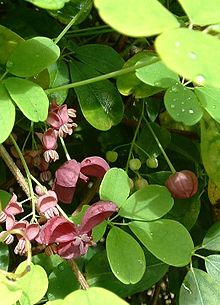Akebia

Akebia is a genus of five species of flowering plant, within the family Lardizabalaceae. The scientific name, akebia, is a Latinization of the Japanese name for species Akebia quinata: akebi (通草).
Akebia is often mentioned in Japanese literature, where it is evocative of pastoral settings.[5] Although the akebi commonly refers to the five-leafed species, the three-leafed species is used in much the same way for novelty food, medicine, and for vine material.
While only a minor food eaten while foraging in the past, akebia is considered a specialty crop today, only available when in season. The pods contain a white, semi-translucent gelatinous pulp that is mildly sweet and full of seeds.[6] The taste is described as sweet but rather “insipid”.[6] Some people recollect in idyllic terms how they foraged for it in the hills as children.[7]
The purple-colored, slightly bitter rind has been used as a vegetable in Yamagata Prefecture[7][8] or in those northern areas, where the typical recipe calls for stuffing the rind with minced chicken (or pork) flavored with miso.[8] Minor quantities of akebia are shipped to the urban market as a novelty vegetable.
In addition to consuming the fruit, akebia leaves are also made into a tea infusion.[5] Outside of food and drinks, akebia vines are used for basket-weaving crafts. An old source lists Minakuchi, Shiga and Tsugaru (now Aomori Prefecture) as localities that produced baskets from the vines of trifoliate variety.[9]
